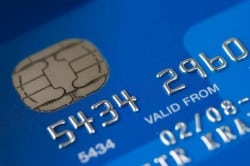 The Preparing Your Small Business for EMV Tip post from back in February provided a primer on the EMV chip standard for credit cards that is just starting to be adopted in the United States, along with what you need to do to get your small business ready to accept EMV “chipped” cards. The roll-out is progressing, and most of you have probably received at least one “chipped” card by now, whether for a personal or small business credit card account.
The Preparing Your Small Business for EMV Tip post from back in February provided a primer on the EMV chip standard for credit cards that is just starting to be adopted in the United States, along with what you need to do to get your small business ready to accept EMV “chipped” cards. The roll-out is progressing, and most of you have probably received at least one “chipped” card by now, whether for a personal or small business credit card account.
While this technology is new in the United States, it has been the standard in most other countries since the late 1990s. And, even with the current push to “chip” all U.S. credit cards ahead of the Liability Shift that took effect in 2015 which makes merchants liable for fraudulent transactions if a customer presents a chipped card and the merchant does not process the transaction using an EMV-compatible card reader, the U.S. will continue to lag behind those other countries. This is because most U.S. issued cards will be implemented as “Chip-and-Signature” which requires signing for a purchase after validating the credit card in an EMV-compatible POS device. Most other countries use “Chip-and-PIN” cards for which instead of signing to authorize a transaction, you enter a PIN number. This is considered to be more secure, because if the physical card is stolen it could not be used without the PIN, which the thief likely will not have.
If your small business is completely domestic, not having a true “Chip-and-PIN” card will not cause any problems; you will simply have to settle for less than optimal security—though using any chipped card at a retail location is more secure than using one with only a magnetic stripe. If you or your staff need to travel internationally—even if just to Canada—you may run into problems. While most major tourist destinations will not only support “Chip-and-Signature” cards, but also traditional magnetic stripe cards, if you are off the beaten path or at unattended kiosks used for purchasing gasoline or train tickets, you may be out of luck if you don’t have a true “Chip-and-PIN” card.
So, how do you get a “Chip-and-PIN” card for your small business? It is not as easy as it sounds. Most card issuers are touting their new “Chipped” cards, but you need to read the fine print to determine whether those cards support PINs, or are only configured for signature authorization. Unfortunately, only a few issuers actually do provide PIN support.
While the following list is not exhaustive, it provides a good starting place if you need a “Chip-and-PIN” card for an upcoming trip. (Note that this is not an endorsement of any of these cards, it is just a place to start your own review.)
Chip-and-PIN Small Business Credit Card
Wells Fargo offers two business credit cards that claim to be enabled for “Chip-and-PIN.” (Read about how Wells Fargo implements EMV chip technology here.) The Wells Fargo Business Platinum credit card offers a credit line of up to $50,000 and is for businesses with annual sales of up to $2 million and a need for no more than 99 cards; the Wells Fargo Business Elite Signature credit card offers a credit line of up to $100,000 and is for businesses with annual sales over $1 million and a need for no more than 200 cards. Both types are available with no annual fee, but a fee is charged to enroll in the cashback rewards program. Among a package of other benefits designed for small businesses, these cards also offer the cool feature of being able to custom-brand your cards for your company. You’ll need to go to a Wells Fargo branch to apply, but you can learn more on their website.
If you don’t absolutely need to use a business credit card, the following consumer cards may work for you. You may be better off using a consumer card anyway.
Chip-and-PIN Consumer Credit Cards with No Foreign Transaction Fees
Many credit cards impose high foreign transaction fees for purchases made in non-U.S. currency. If you’re traveling internationally, these can add up and outweigh any other benefits you might receive for using your credit card. The following card does not charge them.
- Andrews Federal Credit Union Visa Platinum Rewards
In addition to no foreign transaction fees this card offers no balance transfer fees, annual fees or cash advance fees. However, you will need to pay a $5 Credit Union membership fee to apply. The website does not provide details on the rewards program, but does note that you will get 5000 points after your first purchase. Read this overview to learn how to implement “Chip-and-PIN” for your card.
Chip-and-PIN Consumer Rewards Cards
The following card does have foreign transaction fees, but may work for you if your non-international spending will rack up rewards benefits in excess of the fees.
- Wells Fargo Cash Back Visa Signature® Card
Like the Wells Fargo small business card, this credit card also provides “Chip-and-PIN” as described here. It charges a 3% foreign transaction fee (that’s $30 for every $1000 charged), but also provides 1% cash back on all purchases and 5% cash back on all on gas, grocery and drugstore purchases you charge in the first six months you have the card. You also get a host of travel-related benefits such as travel accident & trip cancellation insurance, baggage delay insurance, auto rental damage coverage, access to a concierge, and roadside assistance.
If you’re not planning a trip out of the country in the near future, there is no need to rush out and get a “Chip-and-PIN” card, as it is expected that more issuers will start making the PIN option available towards the end of 2015. However, if you’ll be traveling internationally before that, adding a “Chip-and-PIN” card to your wallet is a prudent move—even if you never have occasion to use it.
See weekly Small Business Tips like this one by subscribing to our blog.


